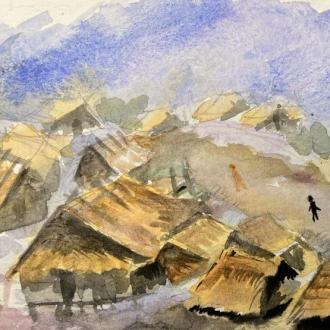
Hay Reh, age about 30 now and living in Indiana after his younger years in South Worcester as a resettling refugee from Burma, does not focus on heritage crafts and their variations as most other members of Refugee Artisans of Worcester do. Rather, he draws on his formal art training first in a refugee camp along the Burma/Thai border, then in public high school in Worcester, then in Quinsigamond Community College, also in the city. Drawing on techniques and art ideas in those venues and meshing these with his memories of life in the refugee camp and in his early resettlement years in Massachusetts, Hay Reh makes watercolor paintings of surpassing beauty. He also draws in charcoal but his watercolors are his forte. Hay Reh sells some of his work through RAW but now also has his own small art business, displaying and selling his works online.
Hay Reh is originally from Kayah State, Burma, the home region of the Karenni ethnic minority. That state is replete in natural resources such as precious minerals, which the Burmese central government and their military wing (the Tatmadaw) have coveted for their own enrichment for decades. At the time Hay Reh was still a baby the Tatmadaw invaded his home village in order to take over gold mining there and hoard its profits for themselves. The soldiers threatened Hay’s family that they would burn down their house if they did not vacate it immediately. The soldiers moved in and, fearing for their lives, the family and many others fled to the United Nations refugee camps for Karenni exiles along the border with Thailand, on the Thai side.
They lost everything but their lives. The trek to the camp was arduous. Hay was only two years old at the time. He and his parents spent 15 years in the camp, whose staff provided the bare necessities for survival, some rudimentary health care, but very importantly hope for the future -- in the form of information about how to apply for refugee resettlement in a third country..
At age 17 he and his family received all the official approvals to come to the U.S. as refugees. This particular camp had better schools than most and offered art lessons for children and youth. Hay Reh enjoyed drawing and watercolor classes there.
In their triple decker in South Worcester the family experienced unusual poverty and stress. Some members were terrified to go outside the house. Hay Reh was enrolled in high school then and found some solace in making art. He also got much mentoring at Worcester Refugee Assistance Project, or WRAP (https://www.worcesterrefugees.org), The tutors there strongly encouraged him to intensify the delight he took in art. In 2015 WRAP’s youth directors Mark Fusuyan and Courtney Temple (then medical students at University of Massachusetts Medical School and now physicians) concluded that the adolescents among the Burmese refugee community had many valuable stories and life history narratives to tell. Courtney and Mark began to collect these and write them down in the teenagers’ own words, to the extent possible.
This resulted in the 2015 booklet When We Were Home: A collection of memories from Burmese refugee youth (Fusuyan, Temple, and Wheelock, WRAP, privately published). Courtney and Mark asked Hay Reh to provide all the illustrations for this small volume. This resulted in a profusion of watercolors, charcoal drawings, and pointillist creations, all on the theme of memories of the refugee journey.
These illustrations are notably non-nostalgic. They show farm women with rice winnowing trays, staring bleakly at the viewer. An obviously distressed second woman glances anxiously at the viewer, over her shoulder. Thatch-roofed homes are depicted in a row, close to a flowing river. Someone is fishing there. Things turn much bleaker in the refugee camp: families did not have enough to eat and Hay depicts quick, furtive, illegal trips outside the camp walls into the nearby jungle as young people collected honey to eat. There are also supernatural visions of old Karenni myths and folktales, often about kingdoms in the past when Karenni people were imagined to be more in control of their lives. Later in the book, as the teenagers’ stories turn to their memories of first arriving in the U.S., phantasmagoric images of neon-colored New York sky scapers appear. Central Park emerges as a dreamscape.
The short printed narratives then grapple with incidents in the first few weeks of resettlement in Worcester, when some families did ‘not yet know how to use’ modern conveniences such as stoves, dishwashers, and furnaces. These tales are related with self-deprecating humor and Hay’s pictures have some of that same modesty and calm avoidance of self-pity.
Hay Reh’s recent venture into setting up his online art-selling business shows much this same cagey self-awareness and resilience.
